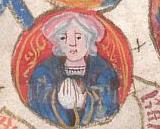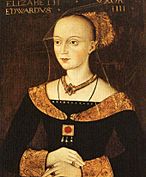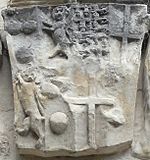Catherine of York facts for kids
Quick facts for kids Catherine of York |
|
|---|---|
| Countess of Devon | |
 |
|
| Born | 14 August 1479 Eltham Palace, Greenwich, England |
| Died | 15 November 1527 (aged 48) Tiverton Castle, Devon, England |
| Burial | 3 December 1527 St Peter's Church, Tiverton |
| Spouse | William Courtenay, 1st Earl of Devon |
| Issue more... |
Henry Courtenay, 1st Marquess of Exeter Margaret Somerset, Baroness Herbert |
| House | York |
| Father | Edward IV of England |
| Mother | Elizabeth Woodville |
Catherine of York (born August 14, 1479 – died November 15, 1527) was an English princess. She was the sixth daughter of King Edward IV of England and his wife, Elizabeth Woodville.
After her father died, Catherine and her siblings were declared illegitimate by her uncle, Richard III. Her mother, fearing for their safety, took them to Westminster Abbey for protection. Later, they moved to a royal palace. When Richard III died, Henry VII became king. He cancelled the law that said Edward IV's children were illegitimate. Henry VII married Catherine's oldest sister, Elizabeth. This made Catherine a valuable person for possible marriages with other royal families.
Catherine was planned to marry John, Prince of Asturias from Spain and later James Stewart, Duke of Ross from Scotland. But neither of these weddings happened. In 1495, Catherine married William Courtenay. He was the son of the Earl of Devon, who strongly supported King Henry VII.
In 1502, Catherine's husband, William, was suspected of being involved in a plot. This plot was linked to a person who claimed to be the rightful king, Edmund de la Pole. William was arrested and lost his property and rights. Catherine, however, stayed free thanks to her sister, Queen Elizabeth. After Henry VII died in 1509, the new king, Henry VIII, forgave William Courtenay. William got his lands back. In 1511, he became Earl of Devon again, but he died a month later from a lung illness.
Catherine became a widow at 31 years old. She promised to never marry again. In 1512, King Henry VIII gave her the right to use all her late husband's lands in Devon for her lifetime. The title of Earl of Devon went to her ten-year-old son, Henry. After her husband's death, Catherine rarely visited the royal court. One time she did was for the christening of King Henry VIII's daughter, Princess Mary, in 1516. Catherine was Mary's godmother. In Tiverton, Catherine was a powerful figure. She owned a large estate and lived a life fitting for a princess. Catherine died at Tiverton Castle when she was 48. She was buried with a grand ceremony in the nearby St. Peter's Church. Catherine's children were the only grandchildren of Edward IV who could claim the English throne through the House of York.
Contents
Early Life and Family
Birth and Childhood
Catherine was born on August 14, 1479, or a little earlier. She was likely born at Eltham Palace in Greenwich. She was the ninth of ten children born to King Edward IV of England and Queen Elizabeth Woodville. Catherine had six sisters. Four of them lived to be adults: Elizabeth, Cecily, Anne, and Bridget.
She also had five brothers. Three were her full brothers, sons of Edward IV. Two were older half-brothers from her mother's first marriage. Her youngest full brother, George, died young. Her other two full brothers, Edward V and Richard, disappeared from the Tower of London in 1483. This happened during the reign of their uncle, Richard III.
A Princess's Early Life
From a young age, Catherine was seen as a good match for marriage. She could be used to form alliances between royal families. In 1479, when she was just a baby, there was a plan for her to marry John, Prince of Asturias. He was the son of the rulers of Spain. An agreement was made in 1479 and confirmed in 1482. However, her father, King Edward IV, died suddenly in April 1483. The marriage plans were then stopped.
After her father's death, a big political problem began. Catherine's older brother, Edward V, became king. But his uncle, Richard, Duke of Gloucester, took control of him. Catherine's uncle and half-brother were arrested. The young king was taken to the Tower of London. His younger brother, Richard, later joined him there. Catherine, her mother, and her other sisters found safety in Westminster Abbey.
On June 22, 1483, Edward IV's marriage to Elizabeth Woodville was declared illegal. This meant all their children, including Catherine, were declared illegitimate. They lost their right to the throne and all their titles. A few days later, Catherine's uncle and half-brother were executed. On July 6, 1483, Richard of Gloucester became King Richard III. Soon after, Catherine's brothers in the Tower disappeared.
In December 1483, Henry Tudor promised to marry Catherine's oldest sister, Elizabeth, if he became king. This was part of a plan with Catherine's mother against Richard III. However, the plan failed. After this, Richard III agreed to talk with Elizabeth Woodville. On March 1, 1484, the king publicly promised that his late brother's daughters would be safe. He said they would not be imprisoned and would be married to "men of noble birth." They would also receive land with income. Catherine and her sisters then moved to the royal palace.
Two years later, in August 1485, Richard III died in battle. Henry Tudor became King Henry VII. He kept his promise and married Elizabeth of York. He also cancelled the law that had declared Edward IV's children illegitimate. In 1492, Catherine's mother, the Dowager Queen, died. Catherine attended her funeral. After this, Catherine lived at the court of her sister, Queen Elizabeth.
Marriage and Challenges
Royal Marriage Plans
Henry VII, now king, wanted to arrange important marriages for his wife's relatives. He wanted to make peace with Scotland. In 1487, an agreement was made for Catherine to marry James Stewart, Duke of Ross. He was the second son of King James III of Scotland. Catherine's sister Cecily was also planned to marry the Scottish heir. However, James III was killed in 1488, and these marriage talks ended.
In October 1495, soon after her 16th birthday, Catherine married William Courtenay. He was 20 years old and the son of the Earl of Devon. The Courtenay family was powerful in Devon and had strongly supported Henry VII. The Courtenay family also had royal connections, being descendants of King Edward I of England.
Catherine and William's marriage was approved by Parliament. Queen Elizabeth paid for William's wedding clothes and gave money for their future children. The Courtenays spent most of their time at court. Catherine received a salary of £50 per year. When not at court, they lived at Tiverton Castle or Colcombe Castle in Devon. Catherine preferred Colcombe. They had three children: two sons, Henry and Edward, and a daughter, Margaret.
Difficult Times
Catherine was very close to her sister, the Queen. She attended the wedding of her nephew, Arthur, Prince of Wales, to Catherine of Aragon in 1501. She also attended the engagement of her niece, Margaret, to the King of Scotland in 1502.
However, a few months later, trouble began. William Courtenay was arrested and sent to prison. He was suspected of being involved in a plot with Edmund de la Pole. William spent several years in prison, even though there was no clear proof of his guilt. His marriage to a princess of the House of York was likely the reason for his arrest. William lost his property and his right to inherit his father's titles. This meant that when his father died, the titles would go to the Crown, not to William or his children.
Thanks to her sister, Queen Elizabeth, Catherine remained free and at court. The Queen made sure Catherine had money to live on. She also arranged for Lady Margaret Coton to care for Catherine's children and provided funds for their upbringing. Catherine's children were moved to a country house for their safety. The Queen paid for their care and even for William's needs while he was in prison.
In June 1502, Catherine's youngest son, Edward, died. This was a very sad time for her. The Queen paid for his funeral and for Catherine's mourning clothes. In February 1503, Queen Elizabeth of York died. This was a huge loss for Catherine, as her sister was her close friend and protector. Catherine led the mourners at her sister's funeral.
Without her sister's support, Catherine turned to her father-in-law for help. The Earl of Devon gave money to his grandchildren, Henry and Margaret. It is believed that her nephew, Henry, Prince of Wales, also helped her.
Later Life and Legacy
Return to Royal Favor
When King Henry VII died in April 1509, Catherine's life changed greatly. Her nephew, Henry VIII, became the new king. He immediately invited her to court and paid for her expenses. Catherine also became a lady-in-waiting to the king's younger sister, Mary. One of Henry VIII's first acts as king was to forgive William Courtenay and return his property.
The Courtenays were present at all court celebrations. They were so well-liked by the young king that Catherine became the only godmother to the king's first son, Henry, Duke of Cornwall, born in 1511.
Catherine's father-in-law died in 1509. William was the rightful heir to the Earl's title and lands. But he needed the king's approval to get them back. Henry VIII set some conditions. One condition was that Catherine give up her claims to certain lands. Catherine agreed, and in April 1511, the agreement was signed. On May 9 or 10, 1511, William Courtenay was officially made Earl of Devon again. The law that had stopped his children from inheriting titles was cancelled. The king also gave them some lands that had been taken from the Courtenay family earlier.
Widowhood and Independence
William Courtenay was already very ill when he got his title back. He died on June 9, 1511, from a lung illness. The king allowed a grand funeral for him. Catherine organized the funeral and made sure daily masses were said for William.
Catherine became a widow at 31. To avoid future marriage plans, she took a vow of celibacy on July 13, 1511. This meant she promised not to marry again. Catherine spent the rest of her life managing her own and her son's properties. In February 1512, the king gave her the right to use all her late husband's lands in Devon for her lifetime.
In 1512, Catherine asked Parliament to allow her ten-year-old son, Henry, to inherit his father's title and lands. After some negotiations, Parliament approved this in November 1512. Henry Courtenay later became a close friend of the king. Catherine herself was also in the king's favor. She signed her letters as "Princess Catherine, Countess of Devon, daughter, sister and aunt of kings." She also used a special royal family crest.
Catherine also arranged a marriage for her daughter, Margaret. Margaret married Henry Somerset. Some stories say Margaret died young, but other records show she visited her cousin, Mary, in 1520.
Final Years and Death
After her husband died, Catherine rarely went to court. She preferred to live at Tiverton Castle or Colcombe Castle in Devon. She often hosted guests at Colcombe. One of her few court appearances was at the christening of Henry VIII's daughter, Mary, in 1516, where Catherine was a godmother.
In Tiverton, Catherine was the head of a powerful family. Her estates brought her a large income of about £2,750 per year. This allowed her to live a very comfortable life. She bought luxury items like spices, wines, and expensive fabrics. She had a beautiful chapel with many religious items. Catherine was friendly with local church leaders. She enjoyed hunting and had jesters and performers visit her home. Even at 45, she was active, riding and managing her business.
Catherine kept good relations with the king and queen. She sent them gifts. She also gave generous gifts to her son, especially when her grandson, Edward, was born. People described Catherine as a very kind person. She was fair to her neighbors and helped the poor.
In the spring of 1524, Catherine became ill. She made her will on May 2, 1527. In her will, she made plans for her soul. She ordered payments for priests to say daily masses for her in St. Peter's Church in Tiverton. She also arranged for poor people to receive money weekly. Catherine died on November 15, 1527, at Tiverton Castle, at about 49 years old. She was buried with a grand ceremony on December 2 in St. Peter's Church. She asked that all her servants attend her funeral in black clothes and receive their yearly salary. Many important people attended her funeral, and money was given to 8,000 poor people to pray for her soul.
Her son had a stone statue placed on her grave. During the English Reformation, the chapel where Catherine was buried was destroyed. Later, a burial site was found with several remains, so it was not possible to identify Catherine's specific remains.
Issue
Catherine and William Courtenay had three children:
- Henry Courtenay (born around 1496 – died January 9, 1539). He became the 2nd Earl of Devon and Marquess of Exeter. He married twice and had two sons from his second marriage, but only one survived.
- Edward Courtenay (born around 1497 – died June 1502). He died as a baby.
- Margaret Courtenay (born around 1499 – died before 1526). She married Henry Somerset. They had no children.
Catherine's children were the only grandchildren of Edward IV who could claim the English throne through the House of York. This claim later caused problems for her descendants. Although Catherine's son, Henry Courtenay, was close to the king for some time, he was arrested in 1538. He was accused of communicating with a cousin who also claimed the throne. Henry, his wife, and his son Edward were imprisoned in the Tower of London. A year later, Henry was executed for treason. His wife was freed but lost her property. Their son, Edward, spent most of his life in prison. He was released during the reign of Queen Mary I. Edward Courtenay died in Italy in 1556. He was the last descendant of Catherine of York.






